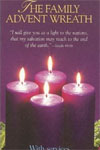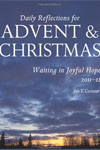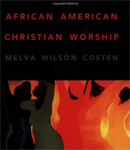|
SECOND SUNDAY OF ADVENT
LECTIONARY COMMENTARY
Sunday, December 9, 2012
Writer for This Unit: Luke A. Powery, African American Lectionary Team member
The unit you are viewing, Second Sunday of Advent, is a compact unit. This means that it does not have a supporting cultural resource unit and worship unit. Instead, to enliven the imagination of preachers and teachers, we have provided scriptural text(s) that we suggest for this moment on the calendar along with a sermonic outline, suggested links, books, articles, songs, and videos. For additional information on Advent, see the archives of the Lectionary for 2008–2011.
I. Description of the Liturgical Moment
The second Sunday of Advent is a time of annual anticipation of and celebration of the birth of God into the world in the flesh of Jesus Christ. It is also the hope for God to come again to redeem God’s people. God coming to the world is the theme of Advent, God’s first coming and second coming. This coming brings hope and humility because we know that God did not have to do it yet we are so glad God did. The hope of Advent stems from the fact that when God comes, things change and are renewed. The status quo is no more in the light of the salvation of God for the world. God comes for all of creation to make all things right. As we wait in expectation, we wait for God to pave a highway to a new way in Christ. In Advent, the beginning of the liturgical year, we yearn for a new beginning in our broken lives, knowing that when God comes, we will be made joyfully whole.
II. Second Sunday of Advent: Sermonic Outline
A. Sermonic Focus Text(s): Isaiah 35:1-10 (New Revised Standard Version)
(v. 1) The wilderness and the dry land shall be glad, the desert shall rejoice and blossom;
like the crocus (v. 2) it shall blossom abundantly, and rejoice with joy and singing.
The glory of Lebanon shall be given to it, the majesty of Carmel and Sharon.
They shall see the glory of the Lord, the majesty of our God.
(v. 3) Strengthen the weak hands, and make firm the feeble knees.
(v. 4) Say to those who are of a fearful heart, ‘Be strong, do not fear!
Here is your God. He will come with vengeance,
with terrible recompense. He will come and save you.’
(v. 5) Then the eyes of the blind shall be opened, and the ears of the deaf unstopped;
(v. 6) then the lame shall leap like a deer, and the tongue of the speechless sing for joy.
For waters shall break forth in the wilderness, and streams in the desert;
(v. 7) the burning sand shall become a pool, and the thirsty ground springs of water;
the haunt of jackals shall become a swamp, the grass shall become reeds and rushes.
(v. 8) A highway shall be there, and it shall be called the Holy Way;
the unclean shall not travel on it, but it shall be for God’s people; no traveller, not even fools, shall go astray.
(v. 9) No lion shall be there, nor shall any ravenous beast come up on it;
they shall not be found there, but the redeemed shall walk there.
(v. 10) And the ransomed of the Lord shall return, and come to Zion with singing;
everlasting joy shall be upon their heads; they shall obtain joy and gladness, and sorrow and sighing shall flee away.
B. Possible Title(s)
i. What Will the Season Bring?
ii. Bad News and Good News
iii. God Is in the Midst of It All
C. Point of Exegetical Inquiry
Each preacher needs to exegete his or her congregation as well as each text. Given that so many are suffering during this season, is it a sign of pastoral incompetence to ignore such suffering? How can preachers best use a text which speaks of pain and lament during the Advent season?
III. Introduction
Advent is typically a liturgical season of hope, but Advent in 2005 was a season of lament for my family. Churches were getting ready for the overflow crowds at Christmas Eve and Christmas Day services, but we were getting ready to bury my ten-year-old niece, Christiana, who died from a rare disease called juvenile dermatamyositis—a long name for a sickness that shortened her young life. I know when people think of Advent, they think of the Christ, but Advent for the Powery family calls us to remember Christiana, the little girl named after the Christ. That particular Advent was not filled with much celebration but lots of lament as I, a minister of the gospel and “Uncle Luke,” prepared to preside over the graveside ceremony of my niece. Like Jesus who wept at the tomb of Lazarus, causing onlookers to say, “See how he loved him!” (John 11:25-26), we wept at the tomb of Christiana as a sign of our love for her, for as Nicholas Wolterstorff says in his book, Lament for a Son, “Every lament is a love-song.”1 Thus, the Advent season is not always an experience of joy for people; it may also be a time of sorrow and sadness, even as we wait for the return of God.
The writer in Isaiah acknowledges that sorrow and sighing have been a part of the human experience of those in exile (v. 10). Talking of those realities fleeing away implies that they were present. There are those with weak hands, feeble knees, and fearful hearts (vv. 3-4). There are those in need of salvation (v. 4) in a holistic sense. The “weight of the world”2 broke the hands, knees, and hearts of those in exile. It was not the best of times, only the worst of times. The imagery in this passage does not allow the reader to skip over the reality of suffering even during the hopeful Advent Season.
One may want to get to the good news right away, but the writer wants us to recognize the bad news first. We should remember that “The Gospel is bad news before it is good news.”3 The images utilized reveal the badness before the gladness—wilderness, dry land, desert, blindness, deafness, lame, speechless, burning sand, thirsty ground, and the haunt of jackals. In other words, the struggles of life are inescapable and a part of human reality. Just as the spiritual “Nobody Knows the Trouble I See” declares “Sometimes I’m up, sometimes I’m down,” those in exile experience the downward spiral of life.
This biblical writer is a realist. He knows that life is not pure ecstasy but is also agony. On various levels, all of creation groans with suffering (cf. Romans 8). In March 2000, horrendous floods hit the country of Mozambique, leaving many homes and lives threatened and lost. It was a sea of death literally. The waters in this context were not life-giving like those in today’s passage. One woman, Ms. Pedro, climbed into a tree for safety and shelter once the floods overwhelmed her home and killed several of her relatives, including her grandmother. She was in the tree for three days. Ms. Pedro knew about feeble knees and a fearful heart. Yet, what is amazing is that in the midst of this silo of suffering and deep sadness, there was a glimpse that sorrow was not infinite.
Just like in this portion of scripture that promises that sorrow and sighing will flee and joy will be everlasting, there was a glimpse of glory, “the glory of the Lord” (v. 2), in Mozambique. The biblical imagery points to the renewal of creation upon God’s arrival—“Here is your God” (v. 4). When God shows up, salvation comes. Salvation is represented by open eyes, hearing ears, the leaping lame, and the singing from the formerly speechless. There will be waters breaking forth in the wilderness, streams in the desert, burning sand becoming a pool, and thirsty ground turning to springs of water (vv. 6-7). This is none other than a new creation for a new day. The old, dry bad news will pass away and give way to the blossoming good news: “Here is your God.”
The way, the “highway” (v. 8), the pathway, “the Holy Way” paved is for a new day and new creation for the redeemed. God’s coming renews joy evidenced in the singing of the songs of Zion. God clears the way such that no lion or ravenous beast shall be there (v. 9), thus nothing will destroy the redeemed. God’s way is a safe space. Against all odds, this is a renewal like no other to help return God’s people to a life of joy. In other words, “weeping may endure for the night but joy comes in the morning” (Psalm 30:5). This is the Advent message—God’s coming in Christ creates newness of life on every level.
IV. Moves/Points
Move/Point One – Sorrow and sighing are part of the human experience.
a. We buried my niece during Advent 2005; that was deep sorrow.
b. Those who endured the exile of which Isaiah spoke knew suffering and sorrow too.
Move/Point Two – The gospel is bad news before it is good news.
a. The Bible represents the fullness of life.
b. A woman in Mozambique survived in a tree for 3 days and gave birth there.
Move/Point Three – We get glimpses of glory.
a. When God is revealed and lives are made better, that is a glimpse of glory.
b. God’s coming in Christ creates newness of life on every level.
V. Celebration
Near the end of Ms. Pedro’s time in the tree during the Mozambique floods, God came in a miraculous way, preparing a “highway” in a tree. Ms. Pedro gave birth to a daughter in a tree.4 An African tree in the midst of death and destruction became a contemporary tree of life. In the midst of death, labor pains gave birth to new life in the form of a newborn baby. This is nothing else than the “glory of the Lord,” a new creation in the middle of devastation.
God is preparing a holy way, a new path, a new creation for us. What we see is not all that we will get! We may be enduring hard times now but God is coming to redeem us, to save us! When God comes, salvation comes. When God comes, something new will happen. Joy will stir in our hearts. Singing will start in our mouths. Redemption will be our theme song as we sing “We’re marching to Zion, beautiful, beautiful Zion . . .”
VI. Sounds, Sights, Smells, and Textures in This Passage
| Sounds: |
hear the crocus singing with joy; hear “Be strong, do not fear! Here is your God, etc.”; hear deaf ears unstopped; hear the speechless sing; hear water in wilderness and streams in desert; hear the springs of water from thirsty ground; hear the singing of the redeemed as they return to Zion with joy;
|
| Sights: |
see the blossoming beginning in the desert; see the glory of the Lord; see blind eyes open; see lame leaping like deer; see the burning sand become a pool; see the redeemed walking on the highway;
|
| Smells: |
smell the wilderness air; smell the blossoming crocus; smell the jackals and grass; and
|
| Textures: |
feel the dry land and the desert; feel the weak hands and feeble knees; feel the water in the wilderness and streams in the desert; feel the heat of burning sand. |
VII. Songs to Accompany This Sermon
A. Well-known Song(s)
- Rise Up, Shepherd, and Follow. Traditional
- Behold the Star. Traditional
- A Strange Way to Save the World. By Dave Clark, Mark Harris, and Don Koch
B. Modern Song(s) (Written between 2005–2011)
- Oh Come. By Luther “Mano” Hanes and Israel Houghton
- Only One. By E. Campbell, T. Campbell, and W. Campbell
- The Gift. By Michael E. Mathis and Billy Thompson
C. Spiritual(s)
- One Day. By J. Wilbur Chapman. Tune by Charles H. Marsh. Arr. by Evelyn Simpson-Curenton
- Your Great Name We Praise (Immortal, Invisible). By Walter Chalmers Smith. Music by Bob Kauflin
- Sign Me Up. By Kevin Yancy and Jerome Metcalfe. Arr. by James Abbington
- O I Want to See Him. By Rufus H. Cornelius
D. Liturgical Dance Music
- Bring Your Praise to the King. Traditional
- Perfect Plan. By John P. Kee
E. Song(s) for the Period of Prayer
- But Who May Abide the Day of His Coming. By Handel
- His Name Shall Be Called. By Martha Munizzi and Marvelyne R.
F. Sermonic Selection(s)
- Rejoice. By Richard Smallwood
- Comfort Ye My People. By George Frideric Handel
G. Benediction Song(s)
- No Greater Gift. By Melvin Williams
- Any Way You Bless Me. By Thomas Whitfield
VIII. Videos, Audio, and/or Interactive Media
IX. Links to Helpful Websites for Advent
X. Books to Assist in Preparing Sermons, Bible Studies, and/or Worship Services Related to Advent
 |
Patterson, Lillie. The Family Advent Wreath Three Panel Brochure: Family Services for Each Sunday in Advent. Nashville, TN: Abingdon Press, 2001. |
|
|
 |
Comier, Jay. Waiting in Joyful Hope. Collegeville, MN: The Liturgical Press, 2011. |
|
|
 |
Costen, Melva Wilson. African American Christian Worship: 2nd Edition. Nashville, TN: Abingdon Press, 2007. |
XI. Notes for Select Songs
A. Well-known Song(s)
- Rise Up, Shepherd, and Follow. Traditional
Location:
Odetta. The Best of Odetta. Westminster, VT: Silverwolf Records, 2011.
- Behold the Star. Traditional
Location:
The Pattersons. The Soul of Christmas, Vol. 1. Jackson, MS: Malaco, 1994.
- A Strange Way to Save the World. By Dave Clark, Mark Harris, and Don Koch
Location:
Hammond, Fred. Christmas…Just Remember. New York, NY: Verity, 2001.
B. Modern Song(s) (Written between 2005–2011)
- Oh Come. By Luther “Mano” Hanes and Israel Houghton
Location:
Israel & New Breed. A Timeless Christmas. New York, NY: Sony Music Distribution, 2006.
- Only One. By E. Campbell, T. Campbell, and W. Campbell
Location:
Mary, Mary. A Mary Mary Christmas. New York, NY: Columbia, 2006.
- The Gift. By Michael E. Mathis and Billy Thompson
Location:
Caesar, Shirley. Giving and Sharing: A Christmas Collection. New York, NY: Word, 2011.
C. Spiritual(s)
- One Day. By J. Wilbur Chapman. Tune by Charles H. Marsh. Arr. by Evelyn Simpson-Curenton
Location:
African American Heritage Hymnal. Chicago, IL: GIA Publications, 2001. #235
- Your Great Name We Praise (Immortal, Invisible). By Walter Chalmers Smith. Music by Bob Kauflin
Location:
Zion Still Sings for Every Generation. Nashville, TN: Abingdon Press, 2007. #4
- Sign Me Up. By Kevin Yancy and Jerome Metcalfe. Arr. by James Abbington
Location:
African American Heritage Hymnal. #192
- O I Want to See Him. By Rufus H. Cornelius
Location:
Zion Still Sings. #137
D. Liturgical Dance Music
- Bring Your Praise to the King. Traditional
Location:
Ward, James. I’ll Be More Like Jesus. Chattanooga, TN: James Ward and New City, 2006.
- Perfect Plan. By John P. Kee
Location:
Kee, John P. & The New Life Community Choir. Christmas Album. New York, NY: Verity, 1996.
E. Song(s) for the Period of Prayer
- But Who May Abide the Day of His Coming. By Handel
Location:
London Celebration Chorus. A Classic Christmas: Handel’s Messiah. Lincoln, NE:
Christian Records, 2003.
- His Name Shall Be Called. By Martha Munizzi and Marvelyne R.
Location:
Munizzi, Martha. When He Came. Goldenrod, FL: Martha Munizzi Music, 2004.
F. Sermonic Selection(s)
- Rejoice. By Richard Smallwood
Location:
Rejoice. New York, NY: Verity, 1997.
- Comfort Ye My People. By George Frideric Handel
Location:
Coley, Daryl and Vanessa Bell Armstrong. Handel’s Messiah: A Soulful Celebration. New York, NY: Warner Alliance, 1992.
G. Benediction Song(s)
- No Greater Gift. By Melvin Williams
Location:
Williams Brothers. Candlelight Christmas. Jackson, MS: Blackberry Records, 1998.
- Any Way You Bless Me. By Thomas Whitfield
Location:
Armstrong, Vanessa Bell. Peace Be Still. Jackson, MS: Malaco, 1984.
Notes
1. Nicholas Wolterstorff, Lament for a Son. Grand Rapids: William B. Eerdmans, 1987, p. 6.
2. See Mark Lewis Taylor, The Theological and the Political: On the Weight of the World. Minneapolis: Fortress Press, 2011.
3. Frederick Buechner, Telling the Truth: The Gospel as Tragedy, Comedy, and Fairy Tale. San Francisco: HarperSanFrancisco, 1977, p. 7.
4. This story can be found at http://news.bbc.co.uk/2/hi/africa/662472.stm.
|